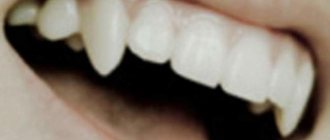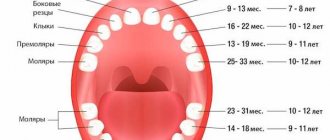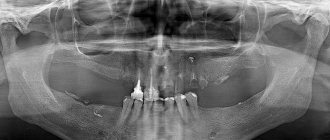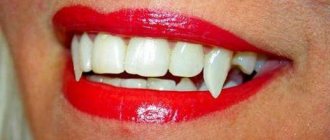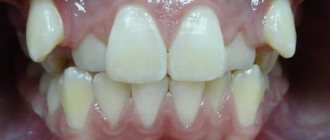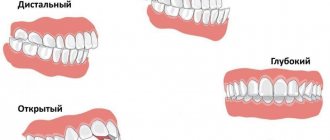Human fangs: what would Darwin say?
There is a lot of debate about why a person needs fangs... No one can say for sure whether it is a relic of the past, an indication of belonging to a predatory species, an unnecessary atavism. The aesthetic view of fangs among their owners also varies. Someone dreams of getting rid of a dubious protrusion in an even row of teeth, while others consider this feature very attractive. One way or another, the apparent “uselessness” of fangs is a very big misconception.
Fangs
The fangs have a cone-shaped elongated shape and are used for tearing, holding food, for defense (in animals), and also for releasing poison (in snakes). In humans, fangs are less affected by caries, because they do not have irregularities on their surface in which pathogenic bacteria would accumulate. Also, the dentin in canines is thicker than in other teeth.
Some animals have overdeveloped fangs - tusks. For example, elephants and walruses. They help the latter to climb out of the water onto the ice or to search for food at the bottom. They help elephants in defense or competition with other males for a female.
What are fangs?
If you count from the center of the jaw, that is, from the separation between the front incisors, the canines are the third teeth. Both the upper and lower jaws have two fangs, with the upper ones being larger than the lower ones. In addition to the fact that these are the tallest and most pointed teeth in all rows, it is the canines that have the deepest and longest roots. The two sides of the fangs meet each other at an angle, forming a cutting tip. On the inside, the fangs are characterized by protrusions at the roots, closer to the gums.
What is noteworthy is that fangs are indeed the only teeth in humans that have retained their original “animal” shape. Other teeth were transformed in one way or another to suit our familiar way of chewing food. In those further away, the crown has become flat, the front teeth are designed to be ground down and crushed. On the border between them there are fangs that have retained the ancient purpose of tearing food and have not lost their original, cone-shaped shape.
Why do people need fangs?
Eye teeth are a rudiment, that is, an inheritance that was inherited from our ancestors, because they ate meat, tearing it with their “fangs”. They are not as developed as in modern predatory animals, because humans are omnivores. Over the years of evolution, they atrophied and ceased to be as noticeable as in predators. For example, if a person stops eating solid food, then all his teeth will be of no use to him and after many years they will simply disappear. Fangs are pulled out only in very extreme cases, because without them the face can change greatly, for example, the cheeks may even sag.
How can fangs interfere?
Many people, for various reasons, dream of getting rid of fangs. The reason for this can be both aesthetic and more serious interference caused by teeth. Incorrect development of canines can lead to malocclusion; their too large size oppresses neighboring teeth, preventing them from developing correctly and often contributing to their crooked growth. There are frequent cases of fangs appearing on a person’s gums: in this case, they hang over the rest of the jaw, disrupting the external attractiveness of the dentition, and thereby annoying their owner.
Functions of incisors
The functional purpose of the incisal group of dental units is determined by their location. They are located in the front part of the oral cavity and serve for the primary processing of food, and also participate in the process of chewing it.
Conventionally, all functions of incisors can be divided into three groups:
- Capture. The front teeth are a kind of gate that opens the way to the oral cavity. They help keep food in the mouth.
- Cutting. When biting off pieces of food with the teeth, a person reflexively begins to chew. The incisors are involved in the primary processing of food, dividing it into small components.
- Chewing. This group of teeth prevents the passage of large pieces that can damage the molars and promotes the proper functioning of the gastrointestinal tract.
Human health directly depends on how well teeth perform their functions. To increase the service life of this important “tool” and protect it from destruction, it is necessary to observe the rules of personal hygiene and monitor the absence of diseases that can lead to the loss of incisors.
Why shouldn't you have your fangs removed?
Getting rid of unwanted and bothersome fangs often seems like the easiest way out of an unpleasant situation. Meanwhile, dentists consider this method to be radical and recommend refraining from getting rid of fangs. If, say, wisdom teeth can be gotten rid of without any consequences, the same cannot be said about fangs. No matter how strange it may sound, canines are extremely important teeth and play a significant role in the proper development and functioning of the jaw. Many doctors even equate the absence of fangs with disability. What is the reason for this attitude?
- Due to their unique structure and deep-set roots, it is the canines that are least susceptible to caries. In turn, this reduces the likelihood of infection spreading to adjacent teeth.
- Human canines perform an important “cutting” function when chewing food; it is possible that their absence will complicate this process. In addition, the absence of fangs can negatively affect diction.
- Once you lose your fangs, you will automatically transfer all the tasks they perform to other teeth. Those who are not at all adapted to this and risk not being able to withstand the load. Such a measure is fraught with grinding and weakening of neighboring teeth. The result will be a complete violation of the beauty and symmetry of the dentition, not to mention your health.
- Being the most stable teeth, canines are reliable assistants and regulators during occlusion (contact of the upper and lower jaws). That is, during eating and when talking, they are the ones who prevent the remaining teeth from grinding against each other.
It is believed that even the highest quality implant is not able to fully replace the removed fang and implement all its functions. This is why professionals recommend looking for other ways to cope with the discomfort caused by fangs. Which ones?
Is it possible to live a full life without teeth?
We can say with confidence: a full life without teeth is impossible. Fangs, incisors and molars are not vital organs, but they have a fairly strong influence on the functioning of the body. Without teeth, it becomes impossible to chew solid food - only ground or soaked food. In addition, the face is often deformed, depressions appear, which looks unaesthetic. Although science knows of cases where people lived for a long time with partial or complete absence of teeth. This phenomenon is called adentia. Adentia can be congenital (primary) and acquired (secondary).
INTERESTING: what is the surface of a tooth?
Congenital adentia is the result of abnormal intrauterine development. It can be partial (when only some teeth are missing) or complete (when no teeth appear at all). Primary adentia is treated with prosthetics. This disease belongs to the specialization of an orthopedic doctor. It is better to seek medical help immediately. If you have the slightest suspicion of a delay in the development of the jaw apparatus, take your child to the doctor.
Human fangs: how to remove them?
- The easiest and shortest way is grinding. In this procedure, the protruding ends of the teeth will be removed and shortened. The doctor will cover the top of the tooth with special enamel. Among the advantages of the method are speed and painlessness. Among the disadvantages is that sharp edges will remain in any case, and you will have to get used to them - and incorrect development of the bite is not excluded.
- The highest quality alternative with virtually no negative consequences is orthodontic treatment with braces. This is especially recommended for teenagers under 18 years of age - at this age the jaw is not yet fully formed, and many things can be corrected in the shortest possible time. For adults, this process takes much longer (the system can be worn for up to two years), and is not always possible - a specialist can advise you more precisely.
- In addition, there are other, very effective methods for correcting fangs. This includes surgery, laser correction and more. Often such treatment is more expensive, but much less time will be spent on it than on correction with braces.
Of course, there are situations when removal of the fang is the only way out - for example, if it is severely damaged. However, any doctor will try to do everything possible to save your teeth. If the presence of fangs confuses you from a visual point of view, you will probably be interested in the fact that special fang extensions are very common among young people. Many consider this feature original and strive to highlight it. So you just have to reconsider your attitude towards this feature - and the intervention of a doctor will not be required at all.
Signs that make it easy to determine a person’s character by their teeth
Shape of teeth
says a lot about a person, and you can determine
the type of person by his teeth
by paying attention to the following signs of the dentition:
Upper incisors
People with long incisors
They are usually the life of the party, but at the same time they persistently strive for their goals and are quite open in communicating with others.
Large incisors
most often occur in adamant, stubborn people who persistently pursue their goal. Despite their difficult nature, those with large teeth are distinguished by their sincerity.
Large gap between teeth
betrays the explosive nature of their owner. In addition, the hole indicates an addiction to risk, which is not always justified.
It is generally accepted that large, sharp teeth
, including fangs, speak of a person’s aggressiveness. In fact, this is not always the case. In most cases, such teeth reveal a loving person. They can also talk about determination.
For example, if a woman’s upper canines are large and long
, then this can emphasize her kindness and humor.
Evenness of teeth
A person's character can be determined by the curvature or straightness of their teeth. Ideal dentition
speaks of a balanced, calm character. Such people are not afraid to make decisions and take responsibility. They are eloquent, self-confident and ready to go towards their goal no matter what.
The smell of freshly cut grass is the smell of fear.
This is the smell of chemical compounds that plants produce at the moment of attack: when grass is bitten by beetles, when animals chew it, or when a person cuts blades of grass with a sharp lawn mower.
Photo: Alexas Fotos/Pixabay
General concepts about teeth and their classification
Teeth are special bone formations that carry out the primary mechanical processing of food. People have long been accustomed to eating rather tough foods - meat, grains, plant fruits. This food requires considerable effort to process, and therefore healthy teeth have always been considered an indicator that a person eats a varied and good diet.
To begin with, what you need to know about teeth is that they are the only organs in the human body that cannot be restored . Both their apparent reliability and fundamental nature are quickly violated by bad habits and poor care.
And if milk, primary teeth are fragile precisely because of their temporary purpose, then the molars are given to a person for the rest of his life. In general, the entire dentition in a person is divided into the following types:
- fangs;
- incisors (lateral and central, also called lateral and medial);
- molars or large molars (this also includes the upper and lower wisdom teeth that grow in a person in adulthood or young age);
- premolars or small molars.
As a rule, the location of the dentition on the upper and lower jaw is recorded using the so-called dental formula . For molars and milk teeth, this formula differs only in that the molars are most often designated using Arabic numerals, and the milk teeth - with Latin numerals.
For an average adult, the dental formula looks something like this: 87654321|12345678. The numbers indicate teeth - any healthy person must have one canine, 2 incisors, 3 molars on each side, 2 premolars on the upper and lower jaw. As a result, the total quantity is 32 pieces .
For babies who have not yet had their primary teeth replaced, this formula looks different, since there may be about 20 . As a rule, temporary teeth erupt by 2–3 years of age, and by 9–12 years they are completely replaced by permanent teeth. However, not all people can boast of having all 32 sprouted teeth.
Since wisdom teeth or third molars can appear in adulthood, or they can remain completely in their infancy all their lives, in which case a person will have 28 teeth . Moreover, the structure of the lower and upper jaws has certain differences.
Anatomical structure
The anatomy of a human tooth suggests that it is conventionally divided into 3 parts: root, neck and crown. The crown is the part that rises above the gum; it is covered with enamel - the strongest tissue that protects the tooth bone from the negative effects of acids and bacteria. There are several types of crown surfaces:
- The facial is the surface on the side of the lip or cheek.
- Occlusion is the surface in the area of closure with a paired tooth, which is located on the opposite jaw.
- Contact - the surface of the crown, which faces the teeth located in the neighborhood.
- Lingual – internal part. It faces the inside of the oral cavity, that is, the surface that the tongue touches during conversation.
The neck is the part that is located between the root and the crown , connecting them, covered with cement and closed by the edges of the gums. The root is the part with which the tooth is attached to its socket. Taking into account the classification type, the root can have one or more processes.
Histology
The histological structure of all teeth is exactly the same, but all of them have a different shape, taking into account the specific function they perform.
Enamel. It is a durable fabric that consists of 95% of various salts such as zinc, magnesium, copper, strontium, fluorine and iron. And 5% consists of substances such as carbohydrates, lipids, proteins. In addition, the enamel contains a liquid that participates in physiological processes.
At the same time, the enamel also has an outer shell , which is called the cuticle; it covers the chewing surface, but over time the cuticle tends to wear off and become thinner.
Chewing teeth
Chewing teeth are divided into molars and premolars. The latter are located after the fangs in front of the actual molars (molars). Small molars contribute to tearing and grinding food, and molars perform a direct chewing function. They have several roots and canals, which allows them to be attached to the jaw more strongly than other teeth, but due to the many grooves, tubercles and depressions on the surface, the risk of developing caries in them is higher.
Description of the dentition
Incisor teeth. The human jaw is symmetrical and contains the same number of teeth of each type. But there are certain anatomical features of the upper and lower jaw. Let's look at them in more detail.
Incisors are the front teeth . A person has eight of them - 4 at the bottom and 4 at the top. Incisors are needed to bite food and separate it into parts. The peculiarity of the structure of the incisors is that they have a flat, chisel-shaped crown with rather sharp edges.
On anatomical sections there are three tubercles, which are erased throughout life. On the top of the jaw there are two central incisors - the largest of all the incisors in their group. The lateral incisors are similar in shape to the central ones, but smaller in size.
What is noteworthy is that the immediate cutting edge of the lateral incisor also has three tubercles, and often takes on a convex shape as a result of the development of the central tubercle. The root of the incisor takes the shape of a cone, and is flat and single. A distinctive feature of the incisor is that on the side of the tooth cavity there are three pulp tips corresponding to the tubercles of the cutting edge.
The anatomy of the upper teeth is slightly different from the structure of the lower dentition, so in the lower jaw everything is exactly the opposite. The middle incisors are smaller , unlike the lateral ones, and have a shorter and thinner root than the lateral incisors. The outer surface of the cutter is slightly convex, while the inner surface is concave.
The crown of the incisor is curved from the side towards the lips and is very narrow. The cutting edge has 2 angles - in the center, more acute, and inside - more obtuse. The roots have longitudinal grooves.
Chewing teeth and fangs
Fangs are used to break down food into smaller pieces. The anatomy of the fangs is such that there is a groove on the inside of the crown; it disproportionately divides the crown into 2 parts. The cutting edge of the fangs has one pronounced and developed tubercle, this makes the cone-shaped crown often similar to the fangs of a predator.
The canine on the lower jaw is narrower in shape, the ends of the crown are concentrated in the medial tubercle. The canine root is flat, inclined inward and the longest, unlike the roots of other teeth. A person has 2 fangs on both jaws . The lateral incisors with the canines form an arch, where the transition from the incisors to the chewing teeth begins in the corner.
Let us consider the structure of the small chewing tooth first, and then the large chewing tooth. Their main task is thorough processing of food . This function is performed by molars and premolars.
The first premolar (No. 4 in the dental formula) differs from the incisors and canines in its prismatic shape, and there are convex surfaces on the crown. The surface has 2 tubercles - lingual and buccal, with grooves between them.
The buccal tubercle is much larger in size than the lingual one. The root of the first premolar has a flat shape , but with a slight bifurcation into the lingual and buccal parts.
The second premolar is similar in structure to the first, but its buccal surface is much larger, and the root has a compressed anteroposterior direction and a conical shape . In the first lower premolar, the chewing surface is inclined towards the tongue.
The second premolar is larger than the first due to the fact that both tubercles are symmetrical and equally developed, and the depressions in the enamel between them have the shape of a horseshoe. The root is the same as that of the first premolar. has 8 premolars in the dentition , four on each side (on the lower and upper jaws).
In the upper jaw, the first molar is the largest. Its crown is similar to a rectangle, and the chewing surface is diamond-shaped with 4 tubercles. This molar has three roots: one straight - the most powerful, and two buccal - flat, deflected in the posterior direction.
During the closure of the jaws, the first molars rest against each other and form a kind of “limiter ”; because of this, they undergo significant loads throughout a person’s life.
The second molar is smaller . The roots are the same as those of the first molar. The structure completely coincides with the location of the premolars described above.
On the lower jaw, the first molar for chewing food has five cusps. This molar has two roots - the anterior one with two canals, the posterior one with one. In this case, the anterior root is larger than the posterior one. In the lower jaw, the second molar is similar in structure to the first. The number of molars in humans is the same as the number of premolars.
The third molar is called a “ wisdom tooth ,” and a person has four of them in the dentition, two on each jaw. On the jaw below, the third molar has many variations in cusp development. As a rule, there are five of them. And, in general, in a person the structure of a “wisdom tooth” is the same as the structure of a second molar, but the root usually resembles a very powerful and short trunk.
Fang extensions - why do people go for it and is the risk justified?
Modern dentistry has a whole arsenal of techniques and technologies that make it possible to restore the integrity of damaged teeth and the appearance of a smile in a wide variety of clinical cases.
But there are other situations when modeling the shape of individual teeth has nothing to do with violations of their integrity. Today we will talk about canine extensions, which are most often carried out with the goal of adding a “zest” to your smile and your image as a whole.
Lions, hippopotamuses, dogs, and the vast majority of other mammals have fangs. Including in humans. Ours are relatively long and slightly pointed. Fangs sit deeper in our jaws than other teeth, and rise above them at the “exit”. But what do they do among all the others - short and neat? Why are they there? What made them appear?
Contrary to popular belief, they are not needed to tear meat. Everything is much more romantic. In men they are 10% longer than in women, and this is not unique to our species.
In gorillas, our closest relatives, the difference is even greater. Males have fangs twice as long as females.
For the reason that in the communities of these primates there is a fierce struggle for the right to own all the females of the group, and victory usually goes to the male with the longest and most terrifying set of fangs.
Over time, due to the evolutionary validity of this feature, gorillas grew long fangs. People took a slightly different path, which involves their reduction. If you compare them with those of our ancestors such as Ardipithecus or Australopithecus, you will immediately notice the difference.
We now have the shortest canines in the history of Homo Sapiens. Moreover, the difference in length between men's and women's is also the smallest.
We suggest you read: Why do all the teeth hurt on the left side, above and below?
This happened because man abandoned the vicious practice of showing teeth as a means of procreation.
Researchers have not fully understood the reasons that prompted our ancestors to do this.
Perhaps this is due to the fact that human babies became more and more defenseless, and the stronger sex had to spend more time caring for them than winning the next “beloved”.
As a result, we are left with only faint reminders in our mouths of the outlandish way in which our ancestors gained authority among their own kind.
1. They are not long enough to grab and hold prey the way, for example, lions do.
2. You won’t scare anyone away with them - those same hippos do it much better. They only allow us to bite into the food we eat a little better.
However, these teeth are still extremely interesting. If not for the common man, then for anthropologists. These are excellent “markers” that allow us to trace the path our ancestors took across the planet. And to some extent they make us who we are. They are our distinctive feature.
Why does a person sneeze? – During a sneeze, the nose is freed from unwanted particles, such as dust. At the same time, the air comes out of the lungs with such force that it reaches speeds of up to 160 km/h, like a racing car!
Remember, when you sneeze, you must cover your mouth if you are around other people. Because with just one sneeze you can infect about 150 people with germs! Follow this rule especially when you are sick with a cold.
It is also very important to know that you cannot hold back the urge to sneeze when it appears. If you hold your sneeze too hard, you may even get a nosebleed! Remember that sneezing is a natural process in the human body that helps clear the airways of harmful particles.
By the way, a person does not sneeze in a dream, since all the nerves associated with this process also rest.
We feel different tastes with different parts of the tongue. Sweetness is felt by the tip of the tongue, acidity by the sides, and bitterness by the base (that is, its central part).
This photo shows taste buds taken under a microscope. There are about 10,000 taste buds on the tongue that perceive the four main tastes (bitter, sour, sweet, salty).
In newborns, taste buds are located throughout the oral cavity. In addition, they are very sensitive to odors. With age, the sense of smell becomes dull.
Odor-sensitive cells are located in the upper part of the nasal cavity. Odor molecules dissolve in the mucus, and signals are transmitted to the brain via the olfactory nerve. This nerve is connected to a special part of the brain that recognizes odors.
Home experiment. See if you can identify the taste without using your nose. Cut the apple, carrots, cheese and other products of similar density into equal cubes. Close your eyes and nose and ask a friend to give you pieces one by one. Can you feel the difference in taste? Then switch roles with a friend.
Taste buds are taste buds located on the tongue.
A molecule is the tiniest particle of a substance.
The olfactory nerve is the nerve that carries signals about odors from the nose to the brain.
A receptor is a nerve ending that is sensitive to some stimulus.
Baby teeth
The histological and anatomical structure of a baby tooth is similar to the structure of a molar tooth, however, there are certain differences:
- The enamel is thinner, and the dentin composition has less mineralization, unlike permanent teeth, which is why children often develop caries.
- The crown size is much smaller.
- The tubercles on the cutting and chewing surfaces are not so clearly expressed.
- The volume of the root canal and pulp of a baby tooth is much larger in contrast to the volume of a molar, so it is more susceptible to various inflammations.
- The roots are curved towards the lip; they are not as strong and long as the roots of the molars.
- The incisors are more convex.
In the end, I would like to note that, naturally, the arrangement of teeth in the jaw, their structure, and closure are individual in nature for each individual person. But the dental apparatus of every person performs vital functions throughout life, therefore, over time, the dental structure changes.
We must not forget that in dentistry, many pathological processes appear in childhood, so you need to monitor the condition of your teeth from childhood. This will help avoid problems in the future.
Despite its apparent simplicity, teeth are a rather fragile and complex system , with a multi-layer structure, where each layer and element has its own specific purpose, as well as certain properties. And the fact that teeth change only once during a lifetime makes the structure of the human jaw different from the anatomy of the jaw of other representatives of the fauna.
Sequence of formation and growth of human teeth
Like all organs, teeth begin their formation during embryonic development. First, these are small rudiments of future incisors, canines and molars that form in the bone. Over time, they begin to grow, making their way to freedom. This process is called eruption. As a rule, it is painful and severe. A person encounters teething twice: first, milk teeth grow, then they are replaced by permanent ones (for more details, see the article: which teeth are milk and which are permanent: photo). Let's take a closer look at the timing of this in both cases. Teething is a largely individual process, so the table presents average values.
INTERESTING: what organ is this or that tooth responsible for, and is there a relationship between them?
Dairy:
| Name | Age |
| Central incisors | 5-6 months |
| Lateral incisors | 8-9 months |
| Fangs | one and half year |
| First molars | year |
| Second molars | 2 years |
Permanent:
| Name | Age |
| Central incisors | 7 years |
| Lateral incisors | 8 years |
| Fangs | 10-11 years |
| First premolars | 9-10 years |
| Second premolars | 10-12 years |
| First molars | 6 years |
| Second molars | 12 years |
| Third molars | 20-25 years |
INTERESTING: incisor teeth: description of functions with photos
How to determine a person's character by the shape of their teeth
For example, African Americans and Southern Chinese are much more likely to have premolars with two canals rather than one. In addition, among the Asian group, wide and long incisors are more common, and among the Slavs, the first incisors protrude lower than the second, in contrast to the same American standards of the Hollywood smile, where an absolutely even semicircle of the cutting edge of the upper teeth is adopted. However, even based on such purely national traits, people try to interpret the character traits of their interlocutor.
A stubborn and decisive, intuitive and open person has outstanding incisors - physiognomy tells us. Risk-taking and explosive character should be suspected in those with diastema. The gap between the incisors also indicates a person’s willingness to make quick decisions, but an unwillingness to think through their consequences. The soul of the company, judging by the provisions of this “science”, is certainly with long incisors. However, he can make fun of his comrades, often quite viciously.
Long and large fangs signal the aggressiveness of their owner. However, this association has more in common with nature than some other provisions. In addition, prominent fangs are considered a sign of a person’s love of love and his perseverance in achieving his goals. In Japan, large fangs, moreover, located outside the dentition, hint at adolescence, when the orthodontist has not yet taken up the matter. It is these associations that force Japanese women to specifically increase these teeth in order to have more success with men.
Smooth or curved
Prudence, responsibility, self-confidence and even wisdom are attributed to people with perfectly straight teeth. They are generally expected to be mathematically precise and goal-oriented.
Crooked teeth, on the contrary, reveal a person who is hot-tempered, stubborn, and also unsociable, who does not allow the possibility of mistakes both in relation to others and to himself. Even an impossible task, in which such a person believes, he will solve with persistence worthy of better use. On the other hand, those with crooked teeth are credited with excellent intuition and the ability to see a situation from all possible sides.
Small or large
Introverts, according to physiognomists, should get small teeth, and the darlings of fate should get large, dense teeth. And if the incisors are also longer than their neighbors, then wealth, fame and success will literally follow on their heels.
Jaws and character
Even a person’s ability to develop his own personality is reflected in the condition of his teeth. So, for example, it is believed that the upper teeth on the left demonstrate how well a person knows himself and knows how to use his abilities for his own benefit, and on the right they show how easy it is for a person to find his place and “take it.” The lower teeth on the left show the family relationships of their owner, and on the right they reflect his ability to analytically assess reality. Accordingly, dental diseases of the corresponding side indicate problems in one or another area of life.
Body health and dental damage
Increasingly, scientists are talking about the integrity of the entire organism and its indivisibility into individual organs. That is why damage to various parts of the human body immediately affects the condition of his teeth. Thus, liver diseases affect the condition of the fangs, especially the lower jaw. The pancreas, lungs and small intestine give distress signals through the premolars, and joint disease is manifested by the destruction of the incisors.
In addition, the incisors are “responsible” for the kidneys, bladder, and the heart and small intestine are closely connected with wisdom teeth. Such maps of organ correspondence are studied by medical specialists, so if you cannot boast of healthy teeth, we recommend that you undergo a full examination of the body and identify the root of the problem. However, no one has canceled tooth decay due to poor hygiene or ignoring preventive appointments at the dentist.
The modern scientific community does not recognize the existence of such a science as physiognomy, and yet it is sometimes interesting to notice how popular rumors regarding large or small teeth correspond to reality. Still, it should be recalled that modern dentistry can correct almost any dental situation, and careful hygiene and preventive examinations every six months will preserve a beautiful smile for many years.
Helped us: Julia Klouda, head of the popular online magazine about dentistry Startsmile.ru
Large upper incisors indicate the determination of their owner. He is considered a stubborn and adamant person, but at the same time sincere and open. Diastema, or a gap between the incisors, reveals a desperate, intuitive, risky, explosive character. Such a citizen can boast of excellent intuition and the ability to make lightning-fast decisions, the consequences of which he, however, does not care too much about. And long incisors are the prerogative of a good-natured, sociable and often mocking person.
Prominent fangs, which stand out so well from the dentition, are associated with the aggressiveness of their owner. However, protruding fangs can also indicate a person’s expressed love of love , as well as his determination. In Japan, by the way, there is even a fashion for prominent upper canines turned outward. There, men tend to see a woman with such teeth as an eternally young nymph.
Straight teeth
Perfectly straight teeth characterize a responsible, self-confident person who knows how to make smart decisions with the calmness of a Buddha. He has a mathematical mind and a strong desire for success.
Crooked teeth may hint that their owner is an excellent debater
, who is not going to give up his position one iota, does not like to make mistakes and is often overly demanding of himself. He tends to set super-challenging goals that seem unattainable to many, and persistently pursue them. In addition, people with crooked teeth are credited with excellent intuition and the ability to evaluate an issue or problem from all angles.
Dentition and character
Some researchers also consider the relationship between the position of teeth and the ability to self-development. Thus, the left side of the upper dentition speaks of the ability (or inability) to reveal personal potential, the right side speaks of how easy it is for a person to find his place in life. The left side of the lower dentition, in turn, sheds light on family relationships, and the right side sheds light on the owner’s analytical abilities. Damage to teeth in one sector or another indicates problems in a related area
, and vice versa - difficulties in one area or another affect the health of the corresponding teeth.
Human teeth and organs
Adherents of psychosomatics, following the scientists who study it, are confident that tooth disease indicates an ailment of the organ associated with it. Thus, pain in the lower fangs “screams” about problems in the liver, “fives” remind of themselves if the pancreas is suffering, as well as the lungs and small intestines, the incisors ache with arthritis or arthrosis, diseases of the kidneys, bladder and ears. Wisdom teeth are supposedly responsible for the heart and small intestine. There are many such “organ maps”, and scientists are seriously studying them, although they stipulate that sometimes teeth can hurt due to poor oral hygiene or infrequent visits to the dentist.
To be fair, we note that all these fabrications are still at the research stage , and official science does not recognize physiognomy. So whether you should attribute irony to people with long teeth, and stinginess to people with small and sparse teeth, it’s up to you to decide. But you have to admit, it’s interesting to experiment.
How do the senses of smell and taste work?
Smell and taste are sense organs and they are very important for a full human life.
The sense of smell is much stronger than the sense of taste. When tasting food, we rely not only on taste, but also on its aroma and density. We smell smells with our nose. Tiny aromatic molecules enter the nose along with the air. The olfactory receptors in the nose send signals along the nerves to the brain, and it recognizes odors.
The taste buds on the tongue also send taste signals to the brain. When we eat something, the tongue and nose work together to tell the brain what kind of food it is.
